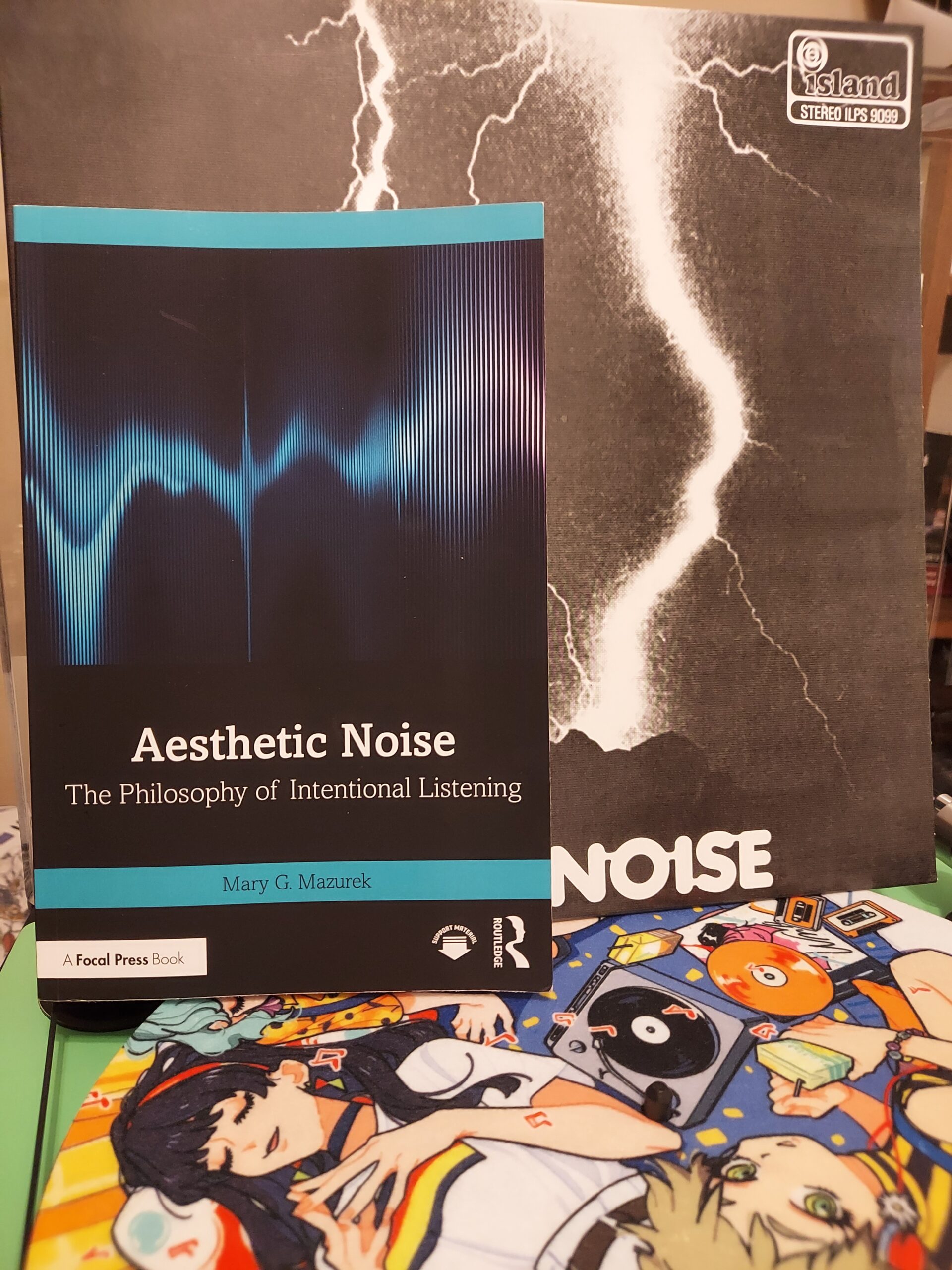I am writing this book review while listening to Delia Derbyshire, Steve Reich, and Melt-Banana. My family is not impressed, but the textures help me concentrate. Their choice of focus ambience is blasting sing-a-longs or podcasts. Words and loudness. Those sounds in addition to other noises like the air-conditioning unit, refrigerator, and fluorescent light hum push my metaphorical buttons. The overstimulation amplifies my lingering post-partum depression and admittedly, I get snappy. Why are some types of noise triggering to me? That’s what Dr. Mary Mazurek wants to find out. Of course, not for me personally, but in taking the torch from Daphne Oram ( see my previous review of An Individual Note), Mazurek is finding out the thought behind noise as an art medium.
Aesthetic Noise: The Philosophy of Intentional Listening is an expansion of Mazurek’s doctoral dissertation. Dr. Mary Mazurek is an assistant professor at the University of Lethbridge, a GRAMMY-nominated recording engineer, the DEI Chair of AES, and interdisciplinary artist, among other important positions. In transforming her dissertation into a book, Mazurek brings her expertise and tests her theories through her students. Aesthetic Noise is a challenging philosophic read because words are defined in context, but it is rewarding in enlightenment and can apply to more than just sonic “noise.”
Mazurek guides us through the various lenses of philosophy and psychology to define beauty and art. We then use them to view noise and the contexts where it can be deemed useful and beauteous. We are still allowed to dislike listening to noise, manipulated or otherwise, but we are given the chance to change our minds. We are invited to explore the works of those who are creating noise as a medium of expression. Mazurek provides examples like Sun O))), Steve Reich, Alyce Santoro and Alison Knowles as a starting point, and a program to prepare us for the experience.
For those who have not given noise a chance, it might seem coincidental that I had mentioned Steve Reich, and that Mazurek dedicates several thought experiments to his works. However I want to highlight Reich’s music as a starting point into aesthetic noise for several reasons. His work is about human justice, and his work (or at least the examples in Aesthetic Noise) uses human speech. Unlike the drones of Sun O))), speech is something that we are used to dedicating attention to. Come Out and Different Trains are both still as relevant as when they were first created. The first using a recording of Daniel Hamm, one of the Harlem Six, a victim of police brutality. The latter piece compared rail travel of Reich’s youth to similar aged individuals who had rode rail cars during the Holocaust. The trauma brought out by both, and the political stances they represent are somehow more controversial in public discourse than Martin Heidegger and Julia Kristeva (also represented in this book). Dr. Mazurek does focus on the message, biography, and impact of Reich’s work, but does not add any outside context to the philosophers whose theories she uses to define art and beauty. It is assumed their names, their philosophical movements, and other background information is known. And maybe, that is a failure on my part, being not the intended audience of post-graduate students of arts and philosophy.
Looking past that Mazurek uses Kristeva and Heidegger in addition to other philosophers like Jacques Derrida, and Aristotle to give noise a chance to be beautiful. In Aesthetic Noise we view noise as truth and revealing, noise in context and through a frame of reference, noise as ugliness to bring about a release of emotion. It is a positive conclusion, and yet it still allows a possibility for its rejection from art. Mazurek also allows the definition of noise to stretch beyond the sonic realm. By using interdisciplinary performances like Happenings and Event Scores (although her examples still use sonic noise as a connecting thread) the possibility of her philosophy can be expanded to cover other mediums of noise.
Aesthetic Noise is more than Advanced Music Appreciation. It is a bridge between the neuroscience of This is What It Sounds Like by Susan Rogers and the manifesto of An Individual Note by Daphne Oram. It is part of the canon to redefine what music composition and art can look like. Included is a post-graduate syllabus of Mazurek’s own Aesthetic Noise class, for those that want to challenge themselves. The appendices of Aesthetic Noise will help those who are more visual or aural learners with playlists, book lists, and references. Also included are the notes from Mazurek’s experience of teaching class, which applies the philosophy to the layperson directly. Although my ears already enjoy aesthetic noise, I feel that I can now dissect my tastes with greater precision.
